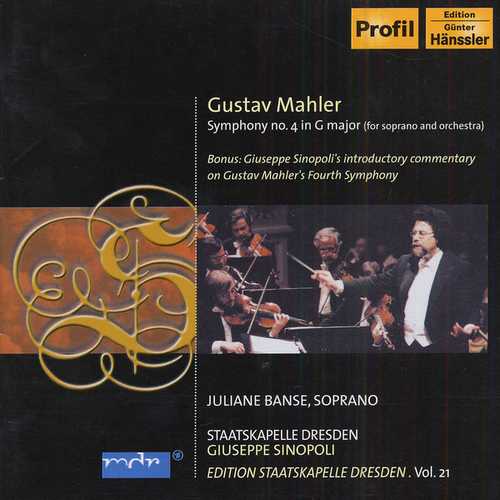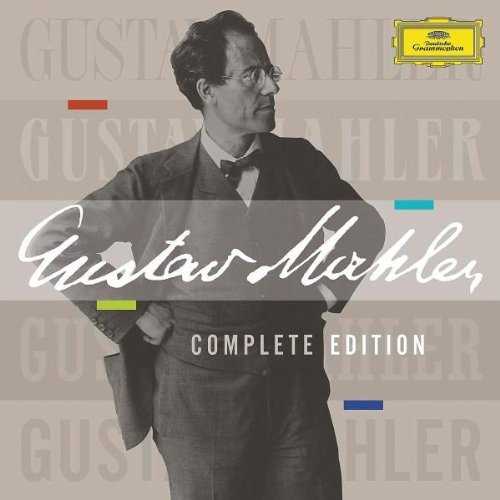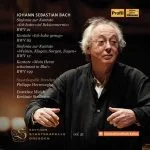
Composer: Gustav Mahler
Performer: Juliane Banse
Orchestra: Staatskapelle Dresden
Conductor: Giuseppe Sinopoli
Format: FLAC (tracks)
Label: Profil Medien
Catalogue: PH07047
Release: 2008
Size: 294 MB
Recovery: +3%
Scan: yes
Symphony No. 4
01. I. Bedachtig, nicht eilen
02. II. In gemachlicher Bewegung, ohne Hast
03. III. Ruhevoll, poco adagio
04. IV. Sehr behaglich
Giuseppe Sinopoli’s intorductory commentary on Gustav Mahler’s Fourth Symphony
05. So wollte ich Sie, […] mit den Anfang der Sinfonie gruben. (I though I would greet you, […] with the opening bars of the symphony.)
06. Ich mochte lhnen nun den Anfang dieses Liedes vorspielen. (I should now like to play the beginning of this song)
07. Der erste Satz, […] ist in Sonatenform Komponiertnen. (The first movement […] is in sonata form.)
08. Nach diesem Auftakt in h-Moll prasentiere… (After this upbeat in B Minor…)
09. Und anschliebend ensteht das zweite Thema des Hauptsatzes: (And then comes the second theme of the first part of the expositon:)
10. Und jetzt der Nachsatz: (And now the after-phrase:)
11. Und jetzt kommt, was oft in der klassischen Musik geschieht… (Now comes something which often happens in Classical music…)
12. Jetzt Kommen wir zu unserem dritten Thema… (Now we come to our third theme…)
13. Und jetzt horen Sie den Seitensatz. (And now you hear the second part of the exposition.)
14. Beethovens Klaviersonate op. 27 Nr.1 enthait imersten Satz ein thema, das absolut […] (The first movemetn of Beethoven’s Piano Sonata Op. 27 No. 1 contains a thema which is absolutely […])
15. Und nochmals die Celli zum Vergleich. (And again the cellos for comparison.)
16. Ich bitte jetzt alle fur das erste Thema des Seitensatzes. (I would now like the first theme of the second part of the exposition from all of you.)
17. Und nun kommt das zweite Thema des Seitensatzes. (and now comes the second theme of the second part of the exposition.)
18. Dann kommt eine Wiederholung. (then comes a repeat.)
Giuseppe Sinopoli, the great Italian conducting psychiatrist, died of a heart attack at the age of 55 leading Verdi’s Aida. He left behind an extensive discography including a complete cycle of Mahler’s symphonies with London’s Philharmonia for Deutsche Grammophon recorded in the late ’80s and early ’90s. This 1999 live recording with the Dresden Staatskapelle is an entirely different and some might say inferior performance. The orchestral playing is arguably better: the Dresden orchestra has a deeply burnished tone, a subtly blended balance, and an amazingly effortless virtuosity that the London players cannot quite match, and the German musicians’ performance is never less than consummately beautiful. Sinopoli, however, seems to be having an off night. His cues are not quite on, his attacks are not altogether precise, and his transitions are not always smooth. Worse yet, his tempo relationships are nowhere near tight enough.
Sinopoli’s recapitulation in the opening movement is far slower than his exposition and his coda is slower still until its final bars, which are far faster than they should be. Similarly, his tempos for the slow movement’s set of double variations fail to cohere, and the closing movement’s tempos are all over the map. This does not mean there are not lovely moments here. The strings in the slow movement’s coda are as warmly consoling as one could hope, and soprano Juliane Banse does a wonderful job of bringing freshness and light to the closing movement. But for those interested in Sinopoli’s way with Mahler’s Fourth, his 1991 Philharmonia recording is a better choice. Hänssler’s live recording is very colorful, but a bit shallow and a tad dry.



